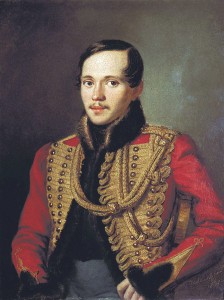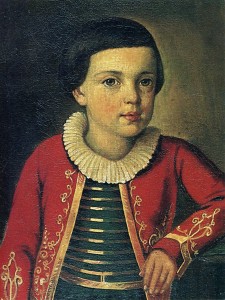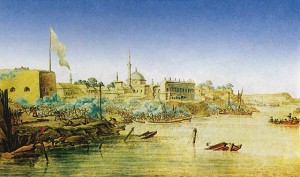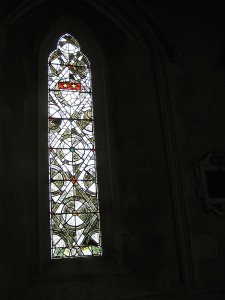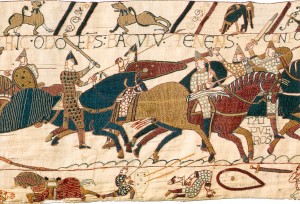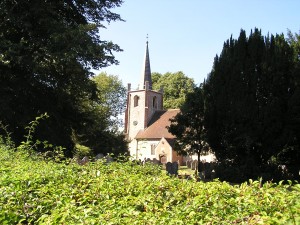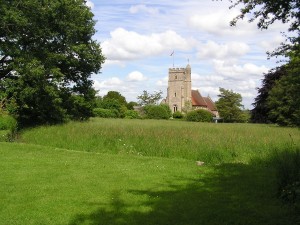The bicentenary next month of Mikhail Yur’evich Lermontov, the great Russian poet, should be marked by a reading or re-reading of his only novel, A Hero of Our Time.
The eponymous hero is the Byronic Pechorin. Cynical, world-weary, bitter and bored, Pechorin represents a literary type known as the ‘superfluous man’, a man, that is, of superior talents, who is yet condemned by the constraints of society and his own lack of purpose to lead a wasted life. The ‘superfluous man’ is a recurrent figure in contemporary Russia literature, the supreme example being Pushkin’s Evgeny Onegin.
Lermontov’s Pechorin is not merely bored but destructive. The novel is as gripping for its romantic locations and dramatic pace as for the psychological unravelling of the hero, whom, in the end, it is impossible to like. Pechorin repeatedly turns away those who would willingly love him: ‘I’m incapable of friendship,’ he says. ‘Of two friends one is always the slave of the other, though often neither will admit it. I can never be a slave, and to command in these circumstances is too exacting, for you have to pretend at the same time. Besides, I have money and servants enough’ (trans. Paul Foote, Penguin edition, 1966, p.100).
While recognising his hero’s ‘malady’, Lermontov is sympathetic to a character who is so clearly modelled on himself. Like Byron, he had been deeply affected by the circumstances of his childhood. His father, Yury Petrovich Lermontov, the head of a minor gentry family, had served in an unfashionable regiment and had retired as a captain. He is said to have been a violent drunk and a womaniser. Lermontov’s mother, Maria, died when he was three and he was brought up by his adoring maternal grandmother, an aristocratic Stolypina. Her late husband, Mikhail Vasil’evich Arseniev, had also served as a captain, but in the Preobrazhensky, the foremost Guards Regiment. Madame Arsenieva considered her son-in-law to be far beneath them and he was kept at a distance.
The Arsenievs were, indeed, a distinguished military family. A distant cousin, Nikolay Dmitrievich Arseniev (1754 – 96), had commanded a column under Suvorov in the assault of Izmail in 1790, for which he is commemorated by Byron in Don Juan (Canto the Eighth, Verse IX) – ‘The columns … though led by Arseniev, that great son of slaughter/As brave as ever faced both bomb and ball’ – lines which young Lermontov was proud to be able to quote in the original. Grandfather Arseniev had, however, bequeathed him his melancholy streak – he had died in 1810 by his own hand, having poisoned himself. The atmosphere was hardly happy, and Lermontov had grown up to be isolated, indulged and introspective.
Commissioned in 1834 into the Guards Hussars Regiment, he had been thrust into St Petersburg society, of which he was sincerely disdainful, as is evident from poems like ‘The First of January’:
‘When the hands of town beauties
Which have long ceased to tremble,
Touch my cold hands with loveless audacity …’
His failures with women, in contrast to his heroes, Pushkin and Byron, fuelled his pessimism whilst spurring his creativity. Personally somewhat unprepossessing, he was described as bow-legged, with a scowling face and droopy moustache. The conquests of both Pushkin and Byron were legion – Pushkin could even boast that he had slept with a woman, Calypso Polichroni, who had been a mistress of Byron – but Lermontov had only one great love affair, with Varya Lopukhina, the model for Vera in Hero of Our Time. Like Vera, she had ended the relationship in order to marry an older man. Lermontov ‘nursed a bitter grievance and frustration forever thereafter. As a result, it could be argued that his feelings and perceptions about love became more intense than those Byron experienced’ (Laurence Kelly, Lermontov, p.192).
Lermontov clearly felt more at home in the Caucasus, the Russian Empire’s ‘Wild West’, to which, in 1837, he was effectively exiled, having denounced the death of Pushkin as a conspiracy. The impression in Hero of Our Time is of bored officers manning remote outposts, drinking and gambling late into the night, hunting furiously during the day and hoping that they will not be picked off by savage Circassians. Lermontov, however, was enchanted by the mountain scenery and relished the solitude. Perhaps, like Pechorin, he enjoyed dressing up in the splendid local costume and going out for long, lonely rides:
‘I fancy the Cossacks gazing idly from their watch-towers must have puzzled long over the sight of me galloping without cause or purpose, for from my clothes they must have taken me for a Circassian. Actually, I’ve been told that on horseback and in Circassian dress I look more like a Kabardian than many Kabardians themselves. Indeed, when it comes to this noble warrior’s dress, I’m quite a dandy: just the right amount of braid, expensive weapons with a plain finish, the fur on my cap neither too long note too short, close-fitting leggings and boots, a white beshmet and a dark maroon top-coat. I’ve made a long study of how the hillmen sit a horse, and nothing flatters my vanity more than to be admired for my mastery of the Caucasian riding style’ (trans. Foote, p.113).
Much has been made of Lermontov’s distant Scottish ancestry, his descent from a certain George Learmont, a mercenary who had been captured at Mozhaisk in 1618, subsequently transferring his allegiance from the Polish to the Muscovite service. Less has been said of his exotic Asiatic ancestry on his mother’s side. The Arseniev ancestor, Aslan-murza Chelebi, was a Tatar prince of the Golden Horde, an undoubted descendant of Chingis Khan, who had in 1389 also transferred to the Russian service and had accepted baptism, the Grand Prince Dmitry Donskoy himself standing as godfather. The family surname derives from Aslan’s son, Arseny Issup Prokof’evich. It is perhaps no wonder that Lermontov felt at home in the wilds! (Nicolas Ikonnikov, La Noblesse de Russie, Tome A.1 (Paris, 1957) and I.1 (Paris, 1959), Arseniev and Lermontov pedigrees.)
